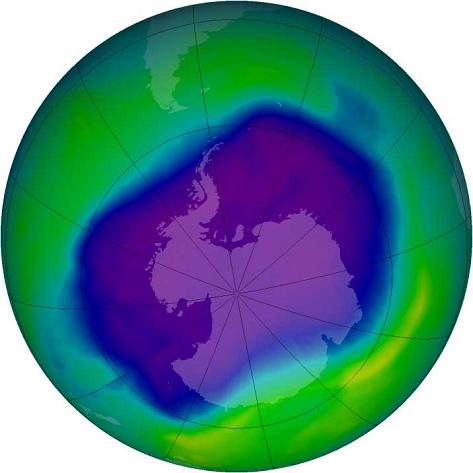Scientists from NASA and the National Oceanic and Atmospheric Administration (NOAA) reported that the hole in the ozone in the South Pole broke the record in terms of area and depth

The ozone layer works to protect life on Earth from the ultraviolet rays from the sun. The "ozone hole" is the depletion of the ozone layer over Antarctica. It is mainly caused by man-made products, which release chlorine- and bromine-based gases into the atmosphere.
From Sept. 21 to 30, the average area of the hole was the largest ever recorded -- 27.5 million square kilometers (10.6 million square miles), said Paul Newman, an atmospheric scientist at NASA's Goddard Space Center in Maryland. If the weather conditions in the stratosphere were normal, the hole in the ozone should only have an area of 23-24 million square kilometers, like the area of North America.
The ozone monitoring system on NASA's Aura satellite measures the amount of ozone from the ground to the upper atmosphere over the entire Antarctic continent. The instrument measured a low concentration of 85 Dobson units on October 8 in the area above the ice sheet in East Antarctica. Dobson units measure the amount of ozone above a certain point in the atmosphere. The ozone monitoring device was developed by the Netherlands Agency for Aerospace Programs in Delft, and the Finnish Meteorological Institute in Helsinki.
Scientists at NOAA's Earth Research Laboratory in Boulder, Colorado used instruments attached to a balloon to directly measure ozone over the South Pole. On October 9, a concentration of 93 Dopson units was recorded compared to approximately 300 units in the middle of July. More importantly, almost all of the ozone layer between 14-20 kilometers above the Earth has been destroyed. Levels of .12 Dobson units were measured in this critical layer. This is compared to 125 Dobson units in July and August.
The data means that ozone has almost disappeared in this layer of the atmosphere, says David Hoffman, director of the Global Monitoring Division of the Earth Research Laboratory. "The depleted layer has expanded so much that it appears that the hole in 2006 had the largest area.
Observations by the Ora satellite in the microwave field showed high levels of the substances that destroy the ozone - chlorine - in the lower atmosphere (at an altitude of about 20 kilometers). These chlorine concentrations covered most of the Antarctic region in the middle and at the end of September, the high chlorine levels were also accompanied by extremely low amounts of ozone.
